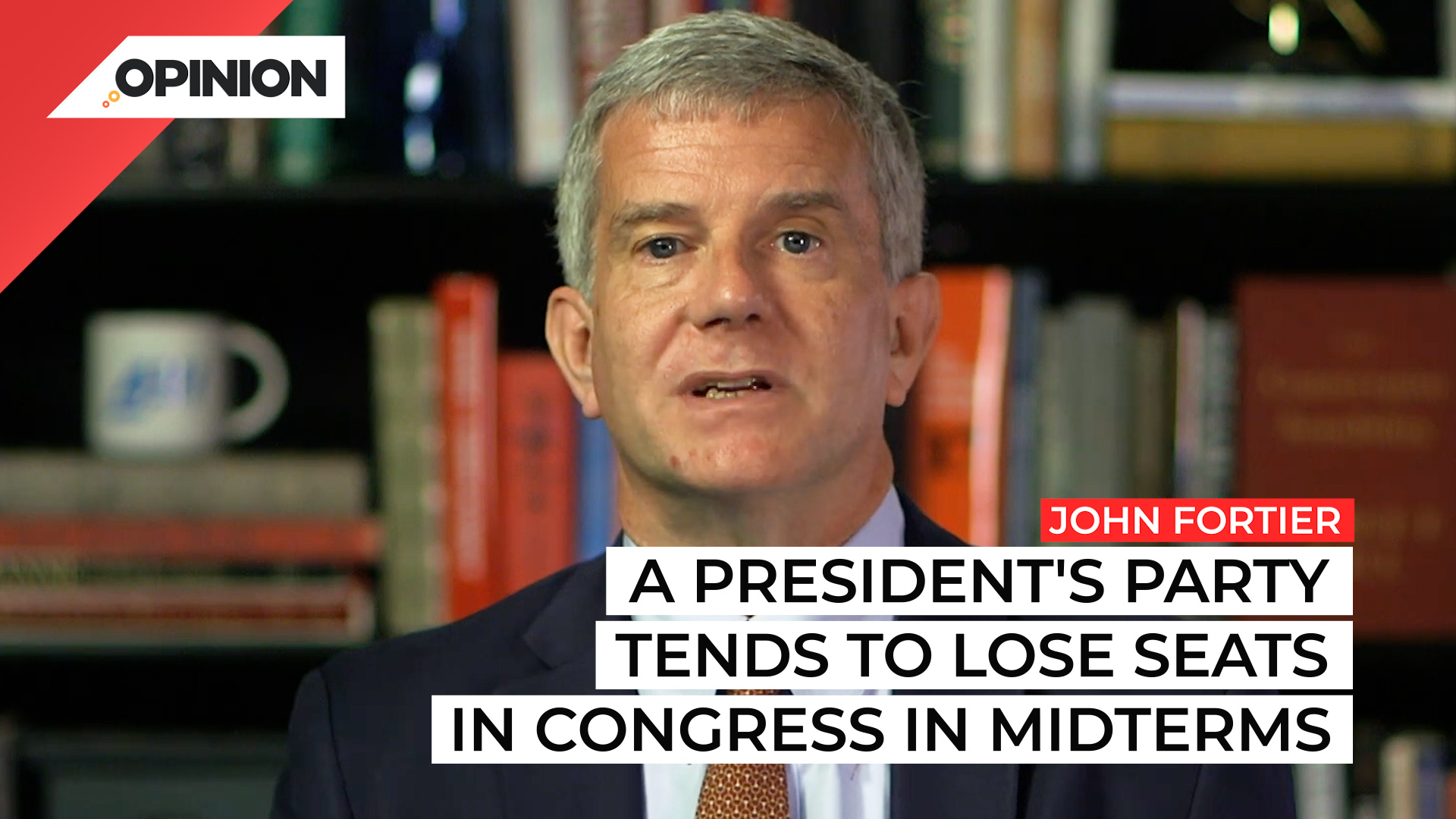
Commentary
-
Our commentary partners will help you reach your own conclusions on complex topics.
What do we know about midterm elections?
This November, when Americans go to the polls, they will find many important offices on the ballot, but not the presidency. The federal elections will be for all of the members of the House of Representatives and approximately one third of senators. And states may also have their own elections for governor, other statewide offices, state legislators, and perhaps local officials and ballot questions.
These elections take place at exactly the mid-point between the previous and the next presidential election and are therefore called midterm elections. While midterm election results may vary from year to year, typically they follow certain patterns.
First, voter turnout rates. Midterm elections have lower turnout than presidential elections. Using two sources of voter turnout produced by Michael McDonald and Curtis Gans, the percentage of eligible voters turning out for a presidential election from 1972-2000 was approximately 55%. Since 2004, turnout has averaged approximately 60%. 2020 set a modern era record of nearly 67 percent of eligible voters casting ballots in a presidential election.
By contrast, midterm elections since 1974 have averaged approximately 40% of eligible voters casting ballots. But, just as our last presidential election set a modern turnout record, so did the last midterm election in 2018, with 50% of eligible voters voting.
A second characteristic of midterm elections is that the party that controls the presidency tends to lose seats in Congress. Since the 1840s, in midterm elections, the president’s party has had a net loss of seats in the House of Representatives in every election but three: 1934, 1998, and 2002. And even in those three exceptional years, the president’s party gained fewer than ten seats.
A similar tendency is seen in other offices. The party in control of the presidency tends to lose seats in state legislatures, the senate and statewide offices. The tendency is strongest in the institutions where the most seats are up for election, such as the House of Representatives and state legislatures and not as strong for offices where only a small number are up for election, for example, the Senate.
This tendency of the party in control of the executive branch losing seats is even seen in other countries.
Third, the losses that the president’s party suffers in the House of Representatives can be quite large. In 1894, with President Grover Cleveland in office, Democrats lost 125 seats in the House. The modern record is a loss of 63 seats by Democrats in the 2010 elections, while Barack Obama was president. And these midterm losses have frequently resulted in the change of party control of the House or Senate. In fact, since Ronald Reagan, all five presidents whose party controlled at least one house of Congress have lost a House or Senate majority at a midterm election.
Fourth, the job approval rating of the president is related to the loss of seats in Congress. The most basic point is that a president with low job approval ratings tends to lose a large number of House seats. Conversely, in the very rare occasion of a president’s party gaining seats, the president has had very high job approval ratings.
Take for example recent presidents who have suffered significant midterm losses. Ronald Reagan in 1982, Bill Clinton in 1994, George W. Bush in 2006, Barack Obama in 2010 and 2014, and Donald Trump in 2018. All saw their presidential job approval ratings in the mid to low 40% range. Each suffered losses of more than 20 seats in the House, and each saw his party lose majority control of the House.
In the two recent examples of a president’s party gaining seats in a midterm election, in 1998 and 2002, in those cases Bill Clinton and George W. Bush had job approval ratings above 60%.
So what does all of this mean for the 2022 midterm election?
President Biden’s job approval rating currently sits at 40% or even slightly below. It is the lowest rating for a president at a midterm election, slightly below the rating of President Trump at the same time in his presidency. If these ratings persist into the fall, history would tell us that Democrats are likely to lose seats in the House and likely the House majority as well. These ratings would likely be a negative factor for Democrats in other races, although the Senate with a small number of seats up for grabs could see the dynamics in individual races also affect the control of the majority.
Of course, we don’t know for sure if conditions might change between now and November, but the strong lesson of history is that a president with low job approval ratings will see midterm elections losses.
-
SCOTUS case on threat of disinformation raises thorny questions
The Supreme Court recently heard arguments concerning government communications with social media platforms in Murthy v. Missouri. Plantiffs in the case claim that government agencies pressured social media companies to remove or restrict posts spreading disinformation about vaccines, elections and COVID-19. Straight Arrow News contributor John Fortier delves into the complex questions raised by the…
-
Trump v. Anderson is more complicated than it looks
The Supreme Court case Trump v. Anderson will decide whether former President Donald Trump is eligible to run as a candidate for president in 2024. Some constitutional law experts have argued that Trump cannot run as a candidate, citing what they say is a clear violation of the 14th Amendment in the U.S. Constitution, which…
-
Era of Iowa, New Hampshire kicking off election season is ending
In American politics, tradition dictates that Iowa and New Hampshire kick off the election season as the two major parties elect their primary candidates. Recently, however, Democrats have suggested revising this tradition, arguing that Iowa and New Hampshire do not present an optimal, comprehensive sample of American voters, and suggesting states like South Carolina or…
-
Why the frenzy over Georgia’s voting laws was misplaced
Georgia Gov. Brian Kemp (R) changed state voting laws after President Joe Biden narrowly won Georgia’s electoral votes over former President Donald Trump in 2020. Voting advocacy groups responded and the U.S. Department of Justice filed a lawsuit against the legislation. These lawsuits alleged that the Georgia GOP in the state legislature aimed to restrict…
-
Changing speakers isn’t actually going to help Republicans
After three weeks without a speaker and three unsuccessful attempts to secure the required votes for a new one, the U.S. House of Representatives elected a little-known Congressman from Louisiana, Rep. Mike Johnson. But was the decision to elect Rep. Johnson, who leans hard-right and pro-Trump, a wise move for the Republican Party? Straight Arrow…
Latest Opinions
-
 Getty Images
Getty Images
More Dems signal willingness to save Johnson from speakership vote
-
 Getty Images
Getty Images
NASA worm returns as interest in space grows around the world
-
 Reuters
Reuters
SF DA seeks restitution for drivers delayed by Golden Gate Bridge protest
-
 Getty Images
Getty Images
Mexico disrupts China’s potential plan to infiltrate US EV market
-
 Getty Images
Getty Images
Free speech fight after USC cancels valedictorian’s speech
Popular Opinions
-
In addition to the facts, we believe it’s vital to hear perspectives from all sides of the political spectrum.


